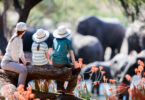Central Asia is a region that is often overshadowed in typical travel narratives. Nonetheless, the area presents a fascinating mixture of cultures, landscapes, and history waiting to be explored. This expanse, stretching across countries like Kyrgyzstan, Kazakhstan, Uzbekistan, and Tajikistan, offers a distinctive blend of ancient heritage and contemporary vibrancy. Far from being a mere passageway between its larger neighbors, Central Asia stands proudly with its richly textured identity.
Here, travelers can immerse themselves in the legacy of the Silk Road, witness the grandeur of snow-capped mountains, and engage with the warm-hearted hospitality of its people. From the rolling steppes of Kazakhstan to the architectural marvels in Samarkand, every corner of Central Asia beckons with its own story. Whether it’s the thrill of adventure, the pursuit of historical wonders, or the exploration of distinctive cuisines, this region promises an array of experiences that defy the ordinary.
Embark on a journey to Central Asia, a land where tradition and modernity converge, offering a travel experience that’s as enriching as it is eye-opening.
Accessibility

Khiva, Uzbekistan
Central Asia’s increasing accessibility, warm hospitality, and picturesque landscapes make it an appealing destination for travelers. Improved transport networks and growing tourist infrastructures, such as modern airports and comfortable accommodations, ease the exploration of this region. The hospitality of locals in countries like Kazakhstan and Uzbekistan is legendary, often inviting visitors to experience their culture firsthand, enhancing the travel experience.
For photography enthusiasts, the diverse landscapes from the vast steppes to the bustling bazaars, and the rich cultural tapestry from traditional attire to ancient architecture, offer endless opportunities to capture stunning and evocative images, making Central Asia a photographer’s paradise.
Cultural Heritage

Registan Square, Samarkand, Uzbekistan
Central Asia is a trove of cultural heritage and architectural masterpieces, deeply rooted in its history as a hub of the Silk Road. In Uzbekistan, the city of Samarkand stands out with its awe-inspiring Registan Square, home to three ornate madrasahs (colleges): Ulugh Beg, Sher-Dor, and Tilya-Kori, each a testament to Islamic architecture’s grandeur. Nearby, the Shah-i-Zinda necropolis offers a walk through beautifully tiled mausoleums.
In Kazakhstan, the ancient city of Turkestan is renowned for the majestic Khoja Ahmed Yasawi Mausoleum, an unfinished yet splendid 14th-century structure symbolizing Timurid architectural ingenuity. Meanwhile, the bustling bazaars of Tashkent, like Chorsu Bazaar, are not just marketplaces but kaleidoscopes of local life and traditions, where one can find exquisite handicrafts and witness the daily rhythms of Central Asian society.
Adventure Tourism

Charyn Canyon, Almaty Region, Kazakhstan
Central Asia’s natural landscapes offer a stunning array of dramatic terrains, ideal for adventure tourism. In Kazakhstan, the vast steppes beckon for horseback riding and wildlife spotting, while the Charyn Canyon, often likened to a smaller version of the Grand Canyon, provides spectacular hiking opportunities. Kyrgyzstan is a paradise for trekkers with its rugged Tien Shan and Pamir Mountains, including the enchanting Ala-Kul Lake trek.
For winter sports enthusiasts, the ski resorts of Karakol in Kyrgyzstan offer excellent skiing and snowboarding options. Tajikistan’s Fann Mountains attract mountaineers and hikers alike, with the shimmering Iskanderkul Lake as a must-visit spot. Adventure-seekers in Uzbekistan can explore the Kyzylkum Desert on a camel safari, experiencing the vast, arid landscape in a traditional way.
Markets and Bazaars

In Central Asia, markets and bazaars are bustling hubs of commerce and culture, offering a sensory journey through the region’s culinary and artisanal wealth. In Uzbekistan, the historic Siyob Bazaar in Samarkand invites travelers to savor local delicacies like samsa (savory pastry) and dried fruits, while marveling at the vibrant array of spices and textiles. Almaty’s Green Bazaar in Kazakhstan is renowned for its diverse food offerings, from fresh produce to local specialties like kurt (yogurt balls) and smoked fish.
Kyrgyzstan’s Osh Bazaar in Bishkek is a treasure for food enthusiasts, where one can indulge in Kyrgyz and regional cuisines, discovering dishes like beshbarmak (lamb with onion borth over noodles) and manti (wrapped meat dumplings). For an authentic taste of Tajik cuisine, the markets in Dushanbe offer traditional bread, dried nuts, and fruits, alongside the famous plov (a rice dish with lamb and spices).
Festivals

Central Asia’s cultural festivals and events are a vibrant showcase of its rich traditions and communal spirit. The region comes alive during Nowruz, the Persian New Year, celebrated with music, dance, and feasts, marking the arrival of spring. In Uzbekistan, the Silk and Spices Festival in Bukhara displays colorful handicrafts and folklore, bringing the Silk Road history to life.
Kyrgyzstan’s World Nomad Games, a spectacular event, features traditional sports like kok-boru and archery, celebrating the nomadic heritage. Kazakhstan hosts the Astana Opera Festival, featuring world-class performances that blend Western and Kazakh music traditions. Each festival offers visitors a distinctive window into the soul of Central Asia, through its art, sport, and celebration of communal life, making these events a must-experience aspect of the region.
You Might Also Enjoy: Safeguarding the Past, Preserving the Future in Asia and Oceania
Wellness Retreats

Issyk-Ata Resort, Kyrgyzstan
Central Asia’s wellness retreats and spiritual journeys offer tranquil experiences amidst its natural and historical landscapes. In Kyrgyzstan, the natural hot springs at Issyk-Kul Lake provide a serene setting for relaxation and rejuvenation. Uzbekistan’s Nuratau Mountains host eco-friendly yurt camps, ideal for yoga and meditation retreats, surrounded by untouched nature.
Tajikistan’s Pamir Mountains, often referred to as the “Roof of the World,” offer spiritual treks where one can connect with nature and local Pamiri culture. These retreats and journeys across Central Asia not only provide physical wellness but also a profound sense of spiritual connection and peace.
FAQs:
Q: What is the best time of year to visit Central Asia?
A: Spring (April to June) and autumn (September to early November) are ideal for visiting Central Asia, offering pleasant weather and fewer tourists. These seasons are perfect for outdoor activities and attending cultural festivals.
Q: Are visas required for travel to Central Asian countries?
A: Visa requirements vary by country and nationality. Some, like Uzbekistan and Kyrgyzstan, offer visa-free or e-visa options for many nationalities. Always check the latest visa policies of each country before your trip.
Q: What are the common languages spoken in Central Asia?
A: Russian is widely spoken across Central Asia, along with local languages like Kazakh, Kyrgyz, Uzbek, Tajik, and Turkmen. English is increasingly common in tourist areas.
Q: What currency is used in Central Asia, and are credit cards widely accepted?
A: Each country has its own currency, like Tenge in Kazakhstan and Som in Kyrgyzstan. Cash is preferred, especially in rural areas. Credit cards are accepted in larger cities and tourist facilities.
Q: Is it safe to travel alone in Central Asia?
A: Central Asia is generally safe for solo travelers, but it’s advisable to stay informed about local customs and exercise usual travel precautions, especially in remote areas.
Q: What is the general attitude towards foreign tourists in Central Asia?
A: Foreign tourists are usually welcomed warmly in Central Asia. The region is known for its hospitality, with locals often eager to share their culture and traditions.
Q: Are there any specific health precautions to take when traveling to Central Asia?
A: Standard vaccinations are recommended, and it’s advisable to drink bottled water. In remote areas, access to healthcare can be limited, so travel insurance with medical coverage is recommended.
Have you ever been to any of the Central Asian countries? Tell us about it in the comments below!








